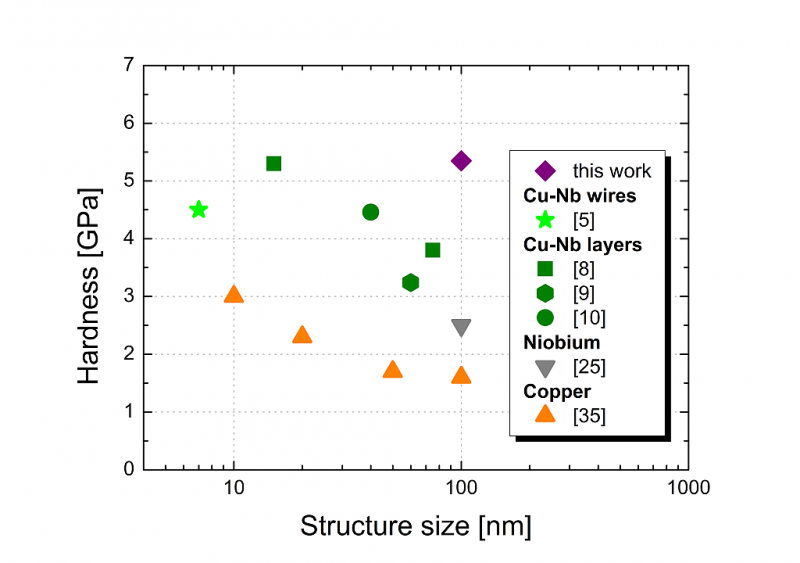Project Leader: Daniel Kiener
In previous investigations it was shown that nanoscaled body centered cubic (bcc) – face centered cubic (fcc) composites exhibit outstanding properties, for example higher hardness or better physical properties. One of these materials is the composite assembled by the fcc element copper (Cu) and the bcc element niobium (Nb). Layered Cu-Nb composites have shown, for example, a high thermal stability as well as a high radiation damage tolerance, making them interesting for prospective use in nuclear reactors.
After first microhardness measurements at room temperature, high temperature nanoindentation to a maximum testing temperature of 500°C was used to investigate mechanical properties as a function of temperature. The focus was set on basic elastic and plastic properties – Young’s modulus and hardness – as a function of time to estimate the maximum operating temperature of the composite. With 5.33 GPa the hardness at room temperature is higher compared to comparable composites, pure Cu, or Nb as shown in Fig. 2.
Furthermore, rate-depending material parameters – strain rate sensitivity and activation volume – were determined to examine the governing mechanism for plastic deformation, giving more detailed insights into the materials behaviour. Finally, the activation energy for plastic deformation was evaluated. The plastic deformation is governed by an interaction of dislocations with sub-grains and grain boundaries. With increasing testing temperature, the strain rate sensitivity raises to a maximum value of 0.106 at 400°C, indicating a deformation governed by thermally activated dislocation interaction in a bimodal microstructure. This increase is followed by a drop to 0.069 at the maximum testing temperature of 500°C, indicating a coarsening of the microstructure, and the limit of thermal stability of the composite, as can be seen in Fig. 3. These findings were confirmed by the temperature dependent changes in hardness, activation volume, and activation energy.
The manufacturing, characterisation by electron microscopy and the microhardness testing was carried out at the Department of Materials Physics at the Montanuniversität Leoben. High temperature nanoindentation testing was performed at the Department for Nuclear Engineering at the University of California, Berkeley, USA.
Recent results on this research field can be found in the publications below:
http://www.sciencedirect.com/science/article/pii/S092150931401507X
doi:10.1016/j.msea.2014.12.020
http://www.sciencedirect.com/science/article/pii/S0925838814030084


